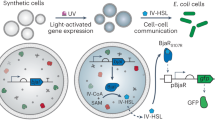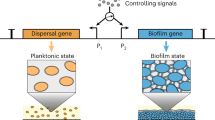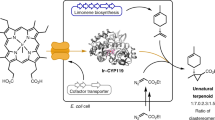Abstract
The design of systems with life-like properties from simple chemical components may offer insights into biological processes, with the ultimate goal of creating an artificial chemical cell that would be considered to be alive. Most efforts to create artificial cells have concentrated on systems based on complex natural molecules such as DNA and RNA. Here we have constructed a lipid-bound protometabolism that synthesizes complex carbohydrates from simple feedstocks, which are capable of engaging the natural quorum sensing mechanism of the marine bacterium Vibrio harveyi and stimulating a proportional bioluminescent response. This encapsulated system may represent the first step towards the realization of a cellular ‘mimic’ and a starting point for ‘bottom-up’ designs of other chemical cells, which could perhaps display complex behaviours such as communication with natural cells.
This is a preview of subscription content, access via your institution
Access options
Subscribe to this journal
Receive 12 print issues and online access
$259.00 per year
only $21.58 per issue
Buy this article
- Purchase on Springer Link
- Instant access to full article PDF
Prices may be subject to local taxes which are calculated during checkout




Similar content being viewed by others
References
Bean, H. D., Anet, F. A. L., Gould, I. R. & Hud, N. V. Glyoxylate as a backbone linkage for a prebiotic ancestor of RNA. Orig. Life Evol. Biosph. 36, 39–63 (2006).
Eschenmoser, A. & Krishnamurthy, R. Chemical etiology of nucleic acid structure. Pure Appl. Chem. 72, 343–345 (2000).
Gilbert, W. The RNA world. Nature 319, 618 (1986).
Laine, R. A. A calculation of all possible oligosaccharide isomers both branched and linear yields 1.05 × 1012 structures for a reducing hexasaccharide: the Isomer Barrier to development of single-method saccharide sequencing or synthesis systems. Glycobiology 4, 759–767 (1994).
Wittung, P., Nielsen, P. E., Buchardt, O., Egholm, M. & Norden, B. DNA-like double helix formed by peptide nucleic acid. Nature 368, 561–563 (1994).
Luisi, P. L. The Emergence of Life. From Chemical Origins to Synthetic Biology (Cambridge Univ. Press, 2006).
Bedau, M. A. et al. Open problems in artificial life. Artif. Life 6, 363–376 (2000).
Deamer, D. A giant step towards artificial life? Trends Biotechnol. 23, 336–338 (2005).
Rasmussen, S. et al. Evolution: Transitions from nonliving to living matter. Science 303, 963–965 (2004).
Glass, J. I. et al. Essential genes of a minimal bacterium. Proc. Natl Acad. Sci. USA 103, 425–430 (2006).
Lartigue, C. et al. Genome transplantation in bacteria: Changing one species to another. Science 317, 632–638 (2007).
Noireaux, V. & Libchaber, A. A vesicle bioreactor as a step toward an artificial cell assembly. Proc. Natl Acad. Sci. USA 101, 17669–17674 (2004).
Monnard, P. A., Luptak, A. & Deamer, D. W. Models of primitive cellular life: polymerases and templates in liposomes. Phil. Trans. R. Soc. B 362, 1741–1750 (2007).
Mansy, S. S. et al. Template-directed synthesis of a genetic polymer in a model protocell. Nature 454, 122–125 (2008).
Murtas, G., Kuruma, Y., Bianchini, P., Diaspro, A. & Luisi, P. L. Protein synthesis in liposomes with a minimal set of enzymes. Biochem. Biophys. Res. Commun. 363, 12–17 (2007).
Ganti, T. The Principles of Life (Oxford Univ. Press, 2003).
Breslow, R. Mechanism of the formose reaction. Tetrahedron Lett. 1, 22–26 (1959).
Cronin, L. et al. The imitation game—a computational chemical approach to recognizing life. Nature Biotechnol. 24, 1203–1206 (2006).
Butlerow, A. Bildung einer zuckerartigen Substanz durch Synthese. Annalen 120, 295–298 (1861).
Pfeil, E. Über den Mechanismus der Cannizzaroschen Reaktion. Chem. Ber. 84, 229–245 (1951).
Lin, B. Z., Yin, C. C. & Hauser, H. The effect of positive and negative pH-gradients on the stability of small unilamellar vesicles of negatively charged phospholipids. Biochim. Biophys. Acta Biomembranes 1147, 237–244 (1993).
Takakura, K., Toyota, T. & Sugawara, T. A novel system of self-reproducing giant vesicles. J. Am. Chem. Soc. 125, 8134–8140 (2003).
Cerc, G. Phospholipids Handbook (Marcel Decker, 1993).
Biegel, C. M. & Gould, J. M. Kinetics of hydrogen ion diffusion across phospholipid vesicle membranes. Biochemistry 20, 3474–3479 (1981).
Shigemasa, Y., Nagae, O., Sakazawa, C., Nakashima, R. & Matsuura, T. Formose reactions. 5. A selective formose reaction. J. Am. Chem. Soc. 100, 1309–1310 (1978).
Shigemasa, Y., Ueda, T. & Saimoto, H. Formose reactions. XXVIII. Selective formation of 2, 4-bis(hydroxymethyl)-3-pentulose in N, N-dimethylformamide-water. Bull. Chem Soc. Jpn 63, 389–394 (1990).
Gao, X., Zhang, Y. & Wang, B. A highly fluorescent water-soluble boronic acid reporter for saccharide sensing that shows ratiometric UV changes and significant fluorescence changes. Tetrahedron 61, 9111–9117 (2005).
Bassler, B. L., Wright, M., Showalter, R. E. & Silverman, M. R. Intercellular signaling in Vibrio-harveyi—sequence and function of genes regulating expression of luminescence. Mol. Microbiol. 9, 773–786 (1993).
Waters, C. M. & Bassler, B. L. Quorum sensing: Cell-to-cell communication in bacteria. Annu. Rev. Cell Dev. Biol. 21, 319–346 (2005).
Chen, X. et al. Structural identification of a bacterial quorum-sensing signal containing boron. Nature 415, 545–549 (2002).
Xavier, K. B. & Bassler, B. L. LuxS quorum sensing: more than just a numbers game. Curr. Opin. Microbiol. 6, 191–197 (2003).
Bassler, B. L., Greenberg, E. P. & Stevens, A. M. Cross-species induction of luminescence in the quorum-sensing bacterium Vibrio harveyi. J. Bacteriol. 179, 4043–4045 (1997).
Lyon, G. J. & Muir, T. W. Chemical signaling among bacteria and its inhibition. Chem. Biol. 10, 1007–1021 (2003).
Zhang, L.-H. & Dong, Y.-H. Quorum sensing and signal interference: Diverse implications. Mol. Microbiol. 53, 1563–1571 (2004).
Rasmussen, T. B. & Givskov, M. Quorum sensing inhibitors: A bargain of effects. Microbiology 152, 895–904 (2006).
Geske, G. D., Wezeman, R. J., Siegel, A. P. & Blackwell, H. E. Small molecule inhibitors of bacterial quorum sensing and biofilm formation. J. Am. Chem. Soc. 127, 12762–12763 (2005).
Persson, T. et al. Rational design and synthesis of new quorum-sensing inhibitors derived from acylated homoserine lactones and natural products from garlic. Org. Biomol. Chem. 3, 253–262 (2005).
Welch, M. et al. Cell-cell communication in Gram-negative bacteria. Mol. Biosyst. 1, 196–202 (2005).
Semmelhack, M. F., Campagna, S. R., Hwa, C., Federle, M. J. & Bassler, B. L. Boron binding with the quorum sensing signal AI-2 and analogues. Org. Lett. 6, 2635–2637 (2004).
Schauder, S., Shokat, K., Surette, M. G. & Bassler, B. L. The LuxS family of bacterial autoinducers: biosynthesis of a novel quorum-sensing signal molecule. Mol. Microbiol. 41, 463–476 (2001).
Xavier, K. B. & Bassler, B. L. Interference with Al-2-mediated bacterial cell-cell communication. Nature 437, 750–753 (2005).
De Keersmaecker, S. C. J. et al. Chemical synthesis of (S)-4, 5-dihydroxy-2, 3-pentanedione, a bacterial signal molecule precursor, and validation of its activity in Salmonella typhimurium. J. Biol. Chem. 280, 19563–19568 (2005).
Miller, S. T. et al. Salmonella typhimurium recognizes a chemically distinct form of the bacterial quorum-sensing signal Al-2. Mol. Cell 15, 677–687 (2004).
Surette, M. G., Miller, M. B. & Bassler, B. L. Quorum sensing in Escherichia coli, Salmonella typhimurium, and Vibrio harveyi: A new family of genes responsible for autoinducer production. Proc. Natl Acad. Sci. USA 96, 1639–1644 (1999).
Song, L. Z. et al. Structure of staphylococcal alpha-hemolysin, a heptameric transmembrane pore. Science 274, 1859–1866 (1996).
Eroglu, A. et al. Intracellular trehalose improves the survival of cryopreserved mammalian cells. Nature Biotechnol. 18, 163–167 (2000).
Nomura, S. et al. Gene expression within cell-sized lipid vesicles. ChemBioChem 4, 1172–1175 (2003).
Sacerdote, M. G. & Szostak, J. W. Semipermeable lipid bilayers exhibit diastereoselectivity favoring ribose. Proc. Natl Acad. Sci. USA 102, 6004–6008 (2005).
Weber, A. L. Sugars as the optimal biosynthetic carbon substrate of aqueous life throughout the Universe. Orig. Life Evol. Biosph. 30, 33–43 (2000).
Chapelle, S. & Verchere, J. F. A boron-11 and carbon-13 NMR determination of the structures of borate complexes of pentoses and related sugars. Tetrahedron 44, 4469–4482 (1988).
van den Berg, R., Peters, J. A. & van Bekkum, H. The structure and (local) stability constants of borate esters of mono- and disaccharides as studied by 11B and 13C NMR spectroscopy. Carbohydr. Res. 253, 1–12 (1994).
Greenberg, E. P., Hastings, J. W. & Ulitzur, S. Induction of luciferase synthesis in Beneckea harveyi by other marine bacteria. Arch. Microbiol. 120, 87–91 (1979).
Gao, X., Zhang, Y. & Wang, B. Naphthalene-based water-soluble fluorescent boronic acid isomers suitable for ratiometric and off-on sensing of saccharides at physiological pH. New J. Chem. 29, 579–586 (2005).
Acknowledgements
We thank B. Bassler for the gift of V. harveyi strain MM32 and J. H. Bayley for the gift of alpha-haemolysin. We would like to thank our Chellnet colleagues (www.chellnet.org) for their input and in particular Lee Cronin, Cameron Alexander and Natalio Krasnogor. We also thank James Errey and Conor Barry for useful discussions during the preparation of this manuscript and the EPSRC (EP/D023343/1, EP/D023327/1, EP/E000614/1) for funding.
Author information
Authors and Affiliations
Contributions
All authors conceived and designed experiments, analysed the data and discussed the results. P.M.G. performed the experiments and P.M.G. and B.G.D. co-wrote the paper.
Corresponding author
Supplementary information
Supplementary information
Supplementary information (PDF 4378 kb)
Rights and permissions
About this article
Cite this article
Gardner, P., Winzer, K. & Davis, B. Sugar synthesis in a protocellular model leads to a cell signalling response in bacteria. Nature Chem 1, 377–383 (2009). https://doi.org/10.1038/nchem.296
Received:
Accepted:
Published:
Issue Date:
DOI: https://doi.org/10.1038/nchem.296
This article is cited by
-
Programmable synthetic cell networks regulated by tuneable reaction rates
Nature Communications (2022)
-
Chemical communication at the synthetic cell/living cell interface
Communications Chemistry (2021)
-
Intercellular communication between artificial cells by allosteric amplification of a molecular signal
Nature Communications (2020)
-
Microfluidic platform enables tailored translocation and reaction cascades in nanoliter droplet networks
Communications Biology (2020)
-
Enzyme-mediated nitric oxide production in vasoactive erythrocyte membrane-enclosed coacervate protocells
Nature Chemistry (2020)



